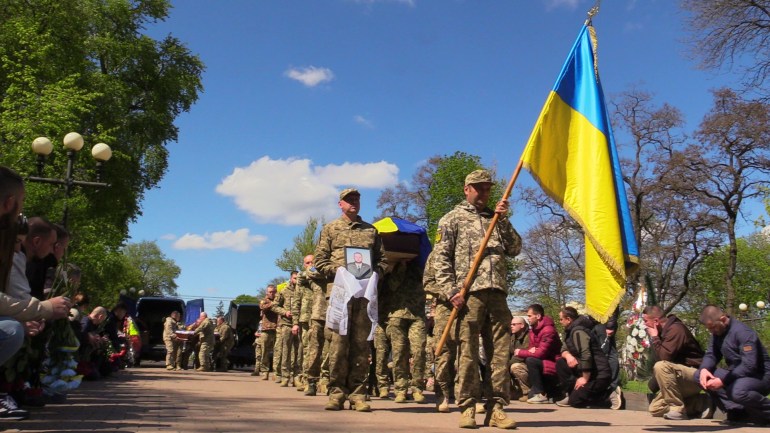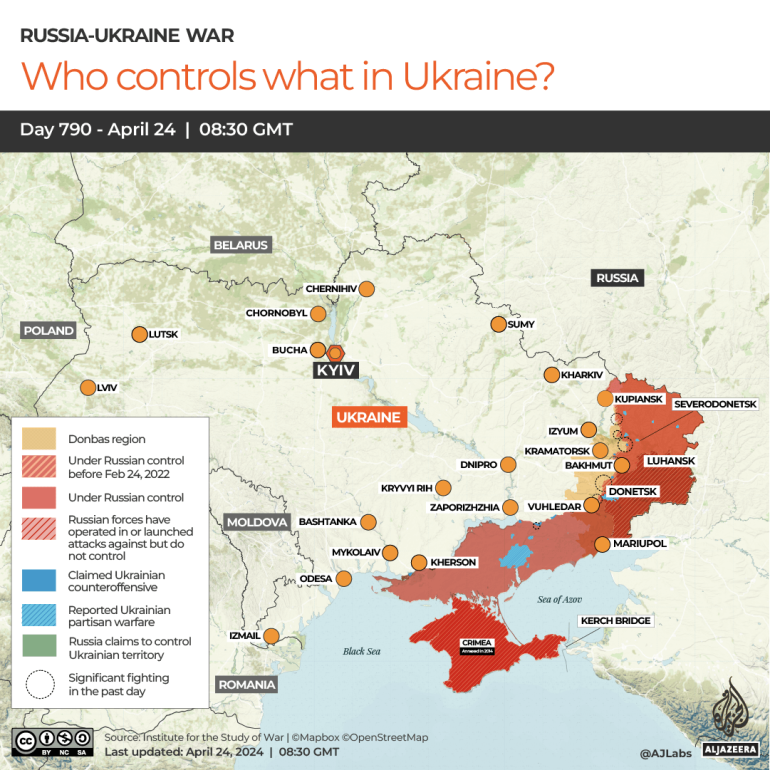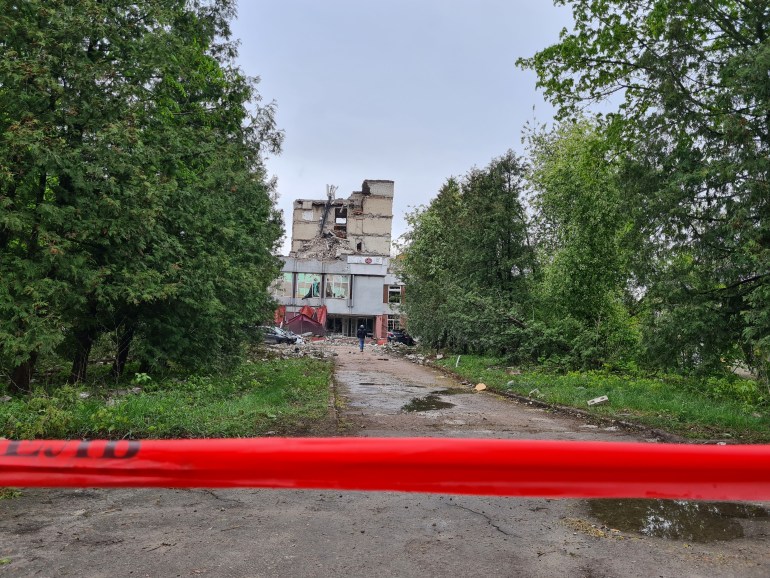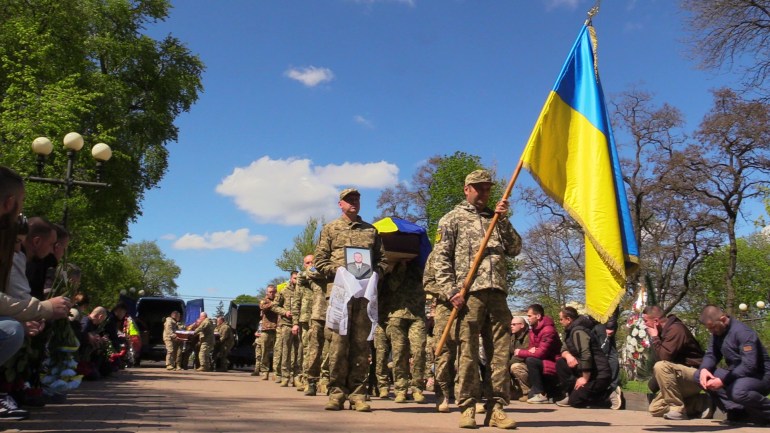Chernihiv, Ukraine – Tamara was pregnant when she had to hide for three weeks in the ice-cold basement of her house in Chernihiv, a northern Ukrainian city.
“When [Russian bomber] planes were above us, the only thing we could do was to pray,” she told Al Jazeera, recalling the war’s beginning in February 2022 that devastated her city and forced two-thirds of its 300,000 residents to leave.
On April 17, she relived this horror when Russian missile strikes here killed 18 people and wounded dozens.
“Why can’t the West understand that every day of the delay means more deaths?” she said on Saturday outside a golden-domed, 17th-century church where a remembrance service for the victims was about to begin.
She was referring to United States military aid that had been stalled in the US House of Representatives since October because of objections from House Republicans allied with former President Donald Trump.
Later on Saturday, the House finally approved the $61bn package – and millions of Ukrainians sighed with relief.

The bill includes $23bn to replenish stockpiles of US-made weaponry and widen future military transfers.
Another $14bn will be used to buy advanced arms directly from US military contractors, and $11bn will fund the US military operations in the region, train the Ukrainian military and boost intelligence cooperation between Kyiv and Washington.
Non-military assistance of $8bn will go to such things as helping President Volodymyr Zelenskyy’s government pay salaries.
A symbolic ‘handout’?
One of Ukraine’s top military experts said the package will not turn the tide of war.
The aid can “improve the situation” on the 1,000km-long (620-mile-long) front line, said Lieutenant General Ihor Romanenko, former deputy chief of the General Staff of Ukraine’s armed forces.
But the aid looks like “a handout to show that we haven’t been forgotten, no more than that”, he told Al Jazeera.
“They’re always late, they hit the brakes, they’re afraid,” he said. “All of that is done to catch up [with Russia], but wars are won by those who act ahead of time.”
The package includes antitank guided missiles and 155mm shells for NATO-standard artillery, which may put an end to the desperate “shell hunger” of outgunned Ukrainian troops.
There are also missiles, armoured vehicles and air defence munitions.
But to advance and win the war instead of containing Russian troops, Ukraine needs longer-range missiles with advanced warheads, better air defence capabilities and F-16 fighter jets, Romanenko said.

In recent months, Russian bombers has been raining down so-called “glide bombs” onto Ukrainian positions on the eastern front, triggering the takeover of the key stronghold of Avdiivka.
The bombs are fitted with wings and guidance systems, carry half a tonne of explosives and can destroy once-impregnable fortifications and hideouts.
“You survive a bombing and then collect the remnants of your brothers-in-arms in a plastic bag,” a Ukrainian serviceman who had been stationed in Avdiivka told Al Jazeera.
Ukraine has long been urging the West to provide F-16s, which could shoot down and shoo away the Russian bombers.
Washington has refused to donate its own planes while other NATO nations have pledged to supply as many as 45 jets.
Kyiv, however, will receive the first six only in July.

The White House was also reluctant to provide another essential weapon – the long-range missile known as the Army Tactical Missile System, or ATACMS, fearing that Kyiv would use them to strike deep within Russia.
Only in September did Ukraine receive a batch of outdated ATACMS missiles and used them to strike two military bases in Russia-occupied regions.
Newer ATACMS missiles with a range of up to 300km (186 miles) have been secretly supplied to Ukraine, the Reuters news agency reported on Wednesday.
The weapons hit a military airfield in Russia-annexed Crimea on April 17, destroying or critically damaging four advanced S-400 air defence systems and three radar stations, it said.
Aid to replenish but ‘not for an advance’
Other observers agreed that the aid package is designed to keep Ukraine on the defensive – and will not allow it to counterattack to regain occupied regions.
The aid “is a surprisingly exact match of Ukrainian military’s needs that mostly has a deficit of air defence weaponry of all kinds and also needs to replenish its arsenal of tank destroyers, anti-infantry landmines and other kinds of ammunition”, Nikolay Mitrokhin of Germany’s Bremen University told Al Jazeera.
“It’s obviously needed to deliver infantry and other ground troops to the front line but not for an advance – otherwise the US would have given tanks,” he said.
Ukrainians with firsthand knowledge of the needs of Ukraine’s military decry the lack of weaponry for a counteroffensive.
“It’s important that the aid doesn’t just help us contain the enemy on Ukraine’s territory but to kick [Russia] back to Ukraine’s 1991 borders,” Oleksandr Antybysh, who volunteers with the Take Back Our History group in Chernihiv, told Al Jazeera.
However, there may be a much more perilous political trap for Ukraine.
By including the Ukraine package in a bill that also provides military aid to Israel and Taiwan, the US shows the world that it equals Ukraine’s and Israel’s archenemies – Russia and Iran – with China, a Kyiv-based analyst said.
“This is a mighty geopolitical slap for China,” Aleksey Kushch told Al Jazeera.
The bill’s approval preceded a visit by US Secretary of State Antony Blinken to Beijing that began on Wednesday.
The US has long been urging China to stop letting Russian companies conduct transactions in yuan and export dual-purpose items such as civilian drones, computer chips and machine tools that can be used in arms manufacturing.
The pressure may force Beijing to seek closer ties with Moscow – and result in it getting additional economic perks from Moscow, which turned its hydrocarbon exports eastwards following Western sanctions over the Ukraine war.
“As the trade turnover between Russia and China rose to $240bn last year, the more the US pushes Beijing, the more discounts for oil and gas China gets from Russia,” Kushch said.
Read More: World News | Entertainment News | Celeb News
Aljazera









